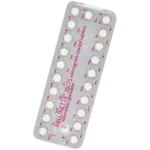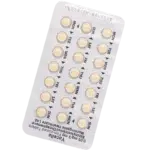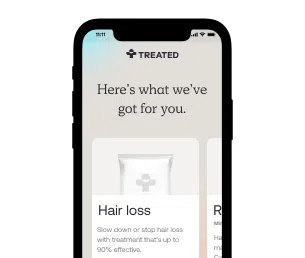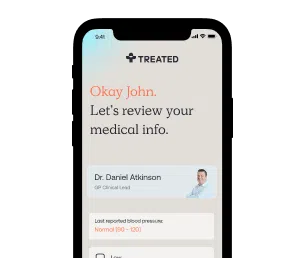Combined pills
The daily pill that protects you against pregnancy.
Secure delivery
UK clinicians
Pinning down the right combined pill for you can be tricky. So let’s take the hassle out of it.
We can show you the different options and make recommendations tailored just for you. Order the combined pill online and get your treatment on subscription.
They’re pills that combine two types of hormone: oestrogen and progesterone. These hormones affect how and when your body prepares for pregnancy.
There are several different types of combined birth control pill and they’re all just about equally effective at preventing pregnancy. However, some contain higher doses of hormones than others, or use different types of progestin and oestrogen. This means one pill might be ideal for easing specific PMS symptoms, while another pill works great for women who are extra-sensitive to hormones.
It can feel a bit overwhelming, so we’re here to help.
The combined pill works in three ways to prevent pregnancy. Here’s the big one: it stops ovulation. That’s when your ovary releases an egg, and it happens once a month. Each egg has the chance to become fertilised, leading to pregnancy. If fertilisation doesn’t happen, the lining of your womb breaks down and the whole thing happens again next cycle (lots of fun, we know).
Because the combined birth control pill stops ovulation, your chances of becoming pregnant are significantly reduced.
The combined birth control pill also protects you by making the mucus in your cervix thicker. “Thick mucus” isn’t something you normally want to hear but in this case, it’s great news. When it’s thicker, sperm have a much harder time reaching the egg.
The pill also makes your uterine lining thinner. This lining builds throughout the month and then breaks down during your period. When you’re using birth control, the lining doesn’t build in the same way. And so the period you have while taking the pill should be shorter, lighter and more predictable.
Any that contain two active ingredients, a progesterone and an oestrogen. To find out if your pill is a combined pill, just check the active ingredients.
In the leaflet that comes with your pill, the ingredients should be clearly listed at the top underneath the name of the drug. For combined pills you should see two ingredients, front and center, that are progestin and oestrogen.
With Loestrin, for example, the active ingredients are norethindrone acetate and ethinyl estradiol. This pill is clearly stated as a progestin-oestrogen combination.
We offer a range of combined birth control pills, so there’s plenty of choice for you. But if you can’t take combination pills, for any reason, it’s important to share this with us for your safety.

How we source info.
When we present you with stats, data, opinion or a consensus, we’ll tell you where this came from. And we’ll only present data as clinically reliable if it’s come from a reputable source, such as a state or government-funded health body, a peer-reviewed medical journal, or a recognised analytics or data body. Read more in our editorial policy.
There are two ways of measuring how effective pills are at preventing pregnancy. One way is according to perfect use. This means you take the pill exactly as you should, every day, without making a mistake. The level of effectiveness of the combined oral contraceptive pill when taken like this is over 99%. So in a whole year, fewer than 1 in 100 women taking the combined birth control in that time will become pregnant.
The other way is typical use. This is when you take the pill but make realistic errors, such as forgetting the occasional pill or taking it late. It’s 91% effective when taken like this, which means about 9 in 100 women taking it over a year will become pregnant.
The best way to make sure the pill is effective then is to follow the instructions as closely as you can when you take it.
It depends on whether you’re taking the pill for the first time, coming back after a break, or switching from a different type of birth control. If you’re using the pill for the first time, you can start on any day.
When you start using the pill on the first day of your period, you’re protected from becoming pregnant immediately — so you don’t need to worry about using a condom. You’ll also be protected immediately if you start taking the pill before the fifth day of your period.
If you start using the pill after the fifth day of your cycle, you won’t be protected right away. Use a back-up birth control method (like condoms) for seven days while the pill starts to work.
Another option is the Sunday start approach. If you start taking the pill on the first Sunday after your period begins, you avoid withdrawal bleeding on a weekend (if you want to skip having your period on a weekend, this is the way to go).
You shouldn’t leave a gap when you’re switching from one birth control method to the combined pill. If you’re already taking a hormonal birth control pill, start your new prescription the day after you finish your last pill.
If you’re using a transdermal patch like Evra, start the pill a day before you’re due to take off the patch. If you’re using the vaginal ring, start the pill a day before you’re set to take out the ring.
If you normally have the Depo-Provera injection, you can start taking your pill up to 15 weeks after your last shot.
And if you have an IUD (copper or hormonal), you should begin your combined birth control pill pack a week before having your IUD removed.

How we source info.
When we present you with stats, data, opinion or a consensus, we’ll tell you where this came from. And we’ll only present data as clinically reliable if it’s come from a reputable source, such as a state or government-funded health body, a peer-reviewed medical journal, or a recognised analytics or data body. Read more in our editorial policy.

How we source info.
When we present you with stats, data, opinion or a consensus, we’ll tell you where this came from. And we’ll only present data as clinically reliable if it’s come from a reputable source, such as a state or government-funded health body, a peer-reviewed medical journal, or a recognised analytics or data body. Read more in our editorial policy.
Have something specific you want to know? Search our info below, or ask our experts a question if you can’t find what you’re looking for.
Estrogen and Progestin (Oral Contraceptives): MedlinePlus Drug Information.

Safest category pill that reduces heavy bleeding. Same hormone mix as Levest and Rigevidon.

Same hormone mix and dose as Femodene and Marvelon. Lower oestrogen version available.

Very similar pill to Cilest and Cilique. Can help to make periods more regular.

Helps with PMS and can make periods more regular. Very similar to Yasmin.

Also known as Cilest. Can help to make your periods more regular.
21-day pill with a seven day break, similar to Norinyl-1. Contains a low dose of oestrogen.

Registered with GMC (No. 4624794)
Meet Daniel
Registered with GPhC (No. 2202465)
Meet Sanjeda
Registered with GPhC (No. 2070724)
Meet Craig
Always read the leaflet that comes with your medication and tell us about any side effects you get.
We know health, but you know you.
Our experts tell you what’s safe, but you decide what’s best.
Answer a few questions and tell us about yourself. Get tailored advice from our clinicians so you can choose better.

Choose your treatment and how often you have it delivered.

We know things change. It’s the nature of life. We’ll check in regularly to make sure your treatment is still right for you.
Pause. Change. Skip. Start again. Any time you like.
Here are some other things we can help with.
Personalised advice. Effective antibiotic treatments to restore balance. Get the help you need for BV.
Pill, patch, ring. We offer a range of birth control options so you can choose the one that's right for you.
Treatments to make your period lighter and more manageable. We'll help you to find the right option for you.
Prevent unplanned pregnancy with emergency contraception. Highly effective Plan B treatments, delivered fast.
Event planned? Period due? Take period delay pills a few days before to delay your bleeding.
Get tailored advice from our expert team, and choose from a range of treatments to reduce symptoms.
We're making healthcare more about you. Sign up to our newsletter for personalised health articles that make a difference.
Disclaimer: The information provided on this page is not a substitute for professional medical advice, diagnosis, or treatment. If you have any questions or concerns about your health, please talk to a doctor.
We couldn't find what you're looking for.
Here's everything we treat. Or, if you're looking for something we don't have yet, you can suggest something.
If there’s a particular treatment or condition you’re looking for, tell us and we’ll look into it for you.
Submit your question here, or tell us if you’ve found an issue on our site.
We’ll get back to you very soon. We aim to respond to all queries in one working day.
You’re signed up to our newsletter. Keep an eye on your inbox for our latest update.
By clicking 'Subscribe now' you're agreeing to our Privacy Policy.
We’ve sent you an email asking you to confirm your email address.